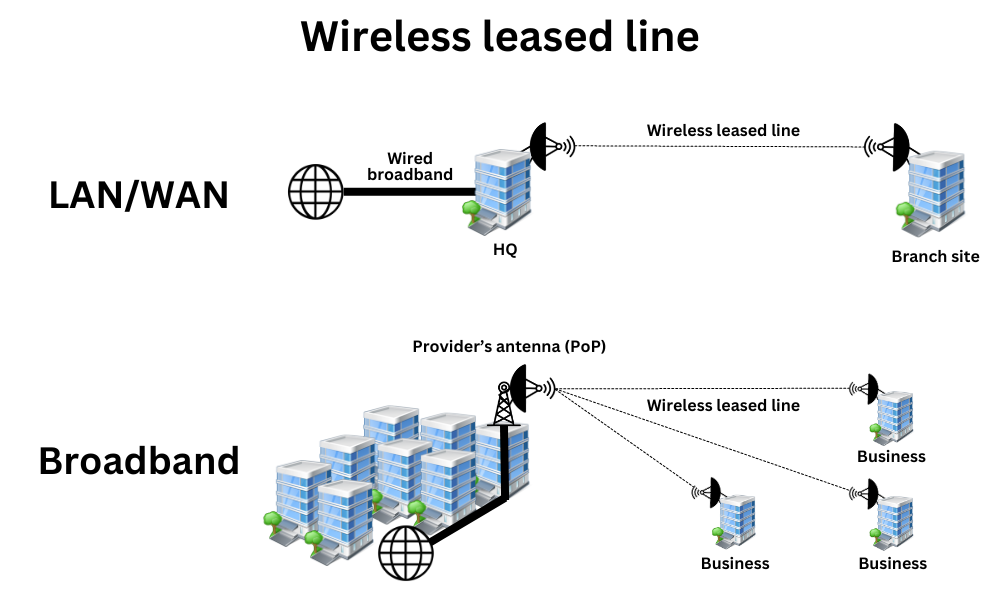Wireless leased lines
Dedicated, high-performance wireless leased line connections are now widely available across the UK, yet many businesses remain unaware.
Starlink satellite internet has been the media’s focus, but it doesn’t offer the required performance to address the persistent challenges of poor VoIP call quality and high latency. We shed light on this niche but powerful solution.
We’ll explain how wireless leased line broadband works, its strengths and weaknesses, key use cases, and the steps to getting one for your business.
Contents:
- What are wireless leased lines?
- Benefits of wireless leased lines
- Wireless leased line use cases
- Getting a wireless leased line
What are wireless leased lines?
A wireless leased line is an internet connection between two antennas pointing at each other. This forms a dedicated, high-performance, point-to-point wireless line that can transmit traffic at high speeds through the air.

It is a niche solution primarily used when laying fibre optic cables between two points is challenging. Here’s are the two solutions provided by a wireless leased line broadband connection:
- Business Ethernet: Dedicated connection between business sites to form a secure link within an internal network.
- Business broadband: Dedicated internet access through a router by connecting to a provider’s antenna.
Here is a summary of the main characteristics of a wireless leased line:
| Characteristic | Description |
|---|---|
| Connection type | Uncontended: Bandwidth is dedicated and constant. Symmetrical: Upload speed = Download speed Wireless: Transmits internet data through the air. |
| Range | Up to 10-20 km (depending on the provider, line-of-sight availability, and technology). |
| Speeds | 100 Mbps (Standard): For SMEs. 1 Gbps (Enhanced): For enterprises or heavy data usage. 5 Gbps (Pro): For data-intensive operations. |
| Reliability | Highly reliable with 99.9%+ uptime. Uses backup solutions or failover mechanisms to ensure service continuity. |
| Service Level Agreements (SLAs) | Guarantees on uptime, latency, and fault resolution times. Commonly offers 4-hour fault repair windows and 100% uptime guarantees (with penalties for non-compliance). |
| Solution type | Can be used to provide broadband to your business if a provider's antenna is in proximity, or more commonly, to interconnect business sites to form a private networks. |
How does wireless leased line work?
Wireless leased lines transmit data without interruption using a range of licensed frequencies. Ofcom offers popular choices such as 18, 28, 38, and 70-80 GHz (E-band).
These frequencies are much higher than WiFi, 4G, and 5G technologies, enabling faster data rates and high broadband cybersecurity through encryption.
The technology relies on narrow-beam transmission between directional antennas, such as parabolic dishes or flat-panel antennas, to guarantee high signal strength over long distances. This approach also minimises interference due to the precise targeting of the signal path between antennas.
To achieve a line of sight, antennas are installed at height, typically on rooftops, towers, masts, poles, or elevated ground. When this cannot be achieved, a repeater dish or relay station can be installed along the path to maintain connectivity.
Understand fixed, dedicated leased lines in more detail with our guide on point to point leased lines.
Benefits of wireless leased lines
Wireless leased lines have several key benefits over other connectivity technologies like fibre optics, mobile and satellite connectivity:
Dedicated wireless
Dedicated wireless broadband offers a private, high-performance connection unaffected by geographical challenges such as hills and rivers, or congestion in the city. Unlike other wireless technologies, it provides exclusive, uncontended bandwidth for optimal performance.
Reliability
This solution ensures reliable connectivity through uncontended bandwidth, symmetrical upload and download speeds, and Service Level Agreements (SLAs), delivering consistent and dependable performance for businesses.
High performance
Point-to-point connections provide superior performance compared to satellite and mobile alternatives. While advancements in 5G and technologies like Starlink may reduce this performance gap in the future, dedicated wireless currently remains a top-tier option.
Fast deployment
With installation typically completed within days using a rooftop antenna, dedicated wireless offers a significantly quicker setup compared to traditional leased line installations, which can take weeks or even months to deploy.
Drawbacks of wireless leased lines
Despite the benefits, wireless leased lines aren’t suitable in most cases as other technologies are usually cheaper or more convenient:
Higher cost
Dedicated wireless broadband often comes with higher monthly fees and requires specialised equipment, making it more expensive than standard leased line broadband prices.
Limited availability
This technology is not available everywhere, particularly in rural areas. Additionally, provider antennas can only support one connection, limiting its accessibility.
Line-of-Sight dependency
A clear line of sight is essential for operation. This requirement typically restricts installations to high buildings or locations above potential obstacles like trees, hills, and temporary obstructions.
Potential for interference
Though rare, factors such as other wireless networks, devices, or even cybersecurity threats like signal jamming can interfere with the connection quality. Adverse weather conditions, such as heavy rain, snow, or dense fog, can impact signal quality and can also affect stability.
Wireless leased line use cases
Wireless leased lines have earned a place in solving niche business connectivity issues in rural and city locations.
Here is a selection of case studies that show how this technology can be key to solving broadband issues:
Leased lines outside the fibre network (Wilkinson Star – Manchester)
Around 30% of UK companies remain outside the full fibre business broadband network without access to uncontended, high-bandwidth leased lines essential for business-grade VoIP and other cloud applications.
These businesses usually lean on workarounds like business broadband redundancy to improve connectivity, but using multiple connections has limited capabilities.
Wilkinson Star, located on Wardley Industrial Estate, struggled with inadequate ADSL connections that hindered their business operations.
They opted for a 20Mb managed wireless leased line, which gave them a dedicated connection without third-party fibre infrastructure. This solution enabled Wilkinson Star to use UCaaS effectively, addressing connectivity issues without relocating.
Bypassing oversubscribed networks (SEE – Manchester)
City areas often have comprehensive broadband coverage, including full fibre. However, the high density of subscribers can overwhelm cabinets and switches, leaving businesses dealing with high contention fibre as their only option, which is far from ideal.
Wireless leased lines can address this gap by using rooftop and facade-mounted antennas to serve areas with insufficient network capacity.
For example, SEE, a Google Ads agency, faced challenges obtaining reliable and fast internet for its central city locations. By deploying a rooftop microwave radio-based wireless leased line, SEE managed to get uncontended bandwidth with scalability for uninterrupted operations.
Failover and disaster recovery (The Pallet Network – Preston)
Wireless leased lines are also used as failover for tethered leased lines. The technology is ideal for this purpose because it:
- Performs similarly to the primary high-performance connection, ensuring minimal operational disruption, and
- It operates on a separate circuit, meaning its uptime and performance are fully independent.
The Pallet Network in Preston required a resilient and diverse internet connection, so it chose a fibre leased line + wireless leased line setup.
This ensured true 100% uptime and no performance reduction with the backup, keeping TPN’s logistics operations running smoothly.
Additionally, the wireless leased line allows them to constantly back up their data to offsite storage or data centres, ensuring that critical information remains protected during system failures, cyberattacks, or natural disasters.
Getting a wireless leased line
If you think a wireless leased line can solve your problems, this is how you go on to get one:
- Find a Provider: Leave us some basic details to request a call back and our networking experts will be in touch to discuss the availability of wireless leased line providers available in your area.
- Assess your needs: Work closely with your provider to determine the bandwidth and reliability your business requires. Consider that:
- Bundling managed services such as business VoIP + leased lines + SD-WAN connectivity is cheaper.
- Longer business broadband contracts are cheaper.
- High-performance connectivity may require upgrading networking components like network switches.
- Other wireless solutions like 5G private networks and business satellite broadband may suffice.
- Site Survey: Once you agree to your service needs, the provider will conduct a site survey to check for line-of-sight feasibility and decide the best locations for the antenna installations.
- Installation: Once approved, the antennas and related equipment are installed, typically on rooftops or poles, to ensure optimal performance. Installation times are much quicker than regular business broadband installation.
- Configuration: The connection is configured, tested for stability, and fine-tuned to meet your specific requirements.
- Go Live: Once the system is operational (usually within a fortnight), your business can benefit from high-speed, dedicated connectivity.
The future of wireless leased lines
Wireless broadband solutions like 5G and Starlink are evolving rapidly, and dedicated, uncontested connectivity may soon become a reality through these technologies.
The expansion of 5G antennas across the UK, alongside Openreach‘s full fibre rollout, is laying the groundwork for dedicated connections through network slicing technologies. Similarly, Starlink and OneWeb are deploying more powerful satellites, enabling higher speeds and greater consistency. Soon, uncontested satellite channels could cater to businesses with specific needs.
While point-to-point wireless leased lines with narrow-beam antennas remain the gold standard, the future points to a convergence of technologies where providers use many technologies simultaneously for seamless connectivity.

